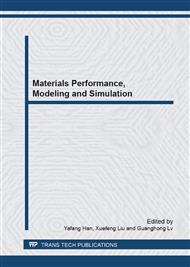[1]
W.M. Thomas, E.D. Nicholas, J.C. Needham, M.G. Church, P. Templesmith C.J. Dawes, GB Patent Application No. 9125978. 9 (December1991).
Google Scholar
[2]
R.S. Mishra, Z.Y. Ma, Mater. Sci. Eng. R 50 (2005) 1–78.
Google Scholar
[3]
Y.R. Wang, Z.D. Zhang, Trans. China Weld. Inst. 27 (2006) 9–12.
Google Scholar
[4]
L. Liu, C. Dong, Mater. Lett. 60 (2006) 2194–2197.
Google Scholar
[5]
T. Kim, J. Kim, Y. Hasegawa, Y. Suga, Proceedings of the Third International Symposium on Designing, Processing and Properties of Advanced Engineering Materials, Jeju Island, South Korea, November 5–8, 2003, p.417–420.
Google Scholar
[6]
M.Z. Khandkar, J.A. Khan, J. Mater. Process Manuf. Sci. 10 (2)(2001) 91–105.
Google Scholar
[7]
M.Z.H. Khandkar, J.A. Khan, A.P. Reynolds, Prediction of Thermal History during Fraction Stir Welding: An Input Torque Based Model, Science and Technology of Welding and Joining.
DOI: 10.1179/136217103225010943
Google Scholar
[8]
K.V. Jata, S.L. Semiatin, Continuous dynamic recrystallization during friction stir welding of high strength aluminium alloys, Scripta Materialia 43 (8) (2000) 743–749.
DOI: 10.1016/s1359-6462(00)00480-2
Google Scholar
[9]
W.B. Lee, Y.M. Yeon, S.B. Jung, The improvement of mechanical properties of friction-stir-welded A356 Al alloy, Materials Scienceand Engineering A355 (2003) 154–159.
DOI: 10.1016/s0921-5093(03)00053-4
Google Scholar
[10]
N. Afrin , D.L. Chen, X. Cao, M. Jahazi, Microstructure and tensile properties of friction stir welded AZ31B magnesium alloy, Materials Science and Engineering A 472 (2008) 179–186.
DOI: 10.1016/j.msea.2007.03.018
Google Scholar
[11]
Squillace, A. De Fenzo, G. Giorleo, F. Bellucci, A comparison between FSW and TIG welding techniques: modifications of microstructure and pitting corrosion resistance in AA 2024-T3 butt joints, Journal of Materials Processing Technology 152. (2004).
DOI: 10.1016/j.jmatprotec.2004.03.022
Google Scholar
[12]
T. Nagasawa, M. Otsuka, T. Yokota, T. Ueki, in: H.I. Kaplan, J. Hryn, B. Clow (Eds. ), Magnesium Technology 2000, TMS, 2000, p.383–387.
DOI: 10.1002/9781118808962.ch53
Google Scholar
[13]
W.B. Lee, Y.M. Yeon, S.B. Jung, Mater. Sci. Technol. 19 (2003) 785–790.
Google Scholar
[14]
Tang W., Guo X., McClure J.C., Murr L.E., Nunes A.: Heat input and temperature distribution in friction stir welding,J. Mater. Process. Manufact. Sci., 1988, vol. 7, pp.163-172.
DOI: 10.1106/55tf-pf2g-jbh2-1q2b
Google Scholar
[15]
S.H.C. Park, Y.S. Sato, H. Kokawa, Metall. Mater. Trans. A 34 (2003)987–994.
Google Scholar
[16]
S.H.C. Park, Y.S. Sato, H. Kokawa, Scripta Mater. 49 (2003) 161–166.
Google Scholar
[17]
C.I. Chang, C.J. Lee, J.C. Huang, Scripta Mater. 51 (2004) 509–514.
Google Scholar
[18]
Caizhi Zhou, Xinqi Yang , Guohong Luan, Investigation of microstructures and fatigue properties of friction stir welded Al–Mg alloy, Materials Chemistry and Physics 98 (2006) 285–290.
DOI: 10.1016/j.matchemphys.2005.09.019
Google Scholar
[19]
G. Bussu, P.E. Irving, Int. J. Fatigue 25 (2003) 77–88.
Google Scholar
[20]
W.B. Lee, Y.M. Yeon, S.B. Jung, Mater. Sci. Technol. 19 (2003) 785–790.
Google Scholar
[21]
Y.S. Sato, M. Urata, H. Kokawa, K. Ikeda, Hall-petch relationship in friction stir welds of equal channel angular-pressed aluminium alloys, Materials Science and Engineering A354 (2003) 298–305.
DOI: 10.1016/s0921-5093(03)00008-x
Google Scholar
[22]
M. Pareek, A. Polar, F. Rumiche, J.E. Indacochea, Proceedings of the Seventh International Conference on Trends in Welding Research, PineMountain, GA, United States, May 16–20, 2005, ASM International, 2006, p.421–426.
Google Scholar


